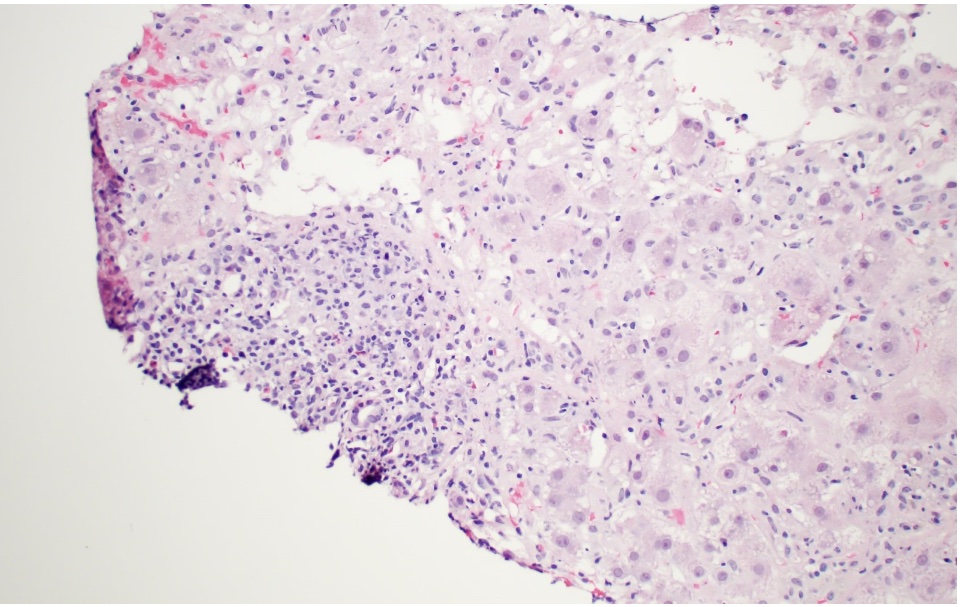Tuesday Poster Session
Category: Liver
P4823 - Acute Liver Failure: A Rare Case of Acute Exacerbation of Autoimmune Liver Disease Triggered by Hantaviral Infection
Tuesday, October 29, 2024
10:30 AM - 4:00 PM ET
Location: Exhibit Hall E

Has Audio

Guneet Sidhu, MD
University of North Dakota
Fargo, ND
Presenting Author(s)
Guneet Sidhu, MD1, Farid Hamedani, MD2, John Bassett, MD, FACG3
1University of North Dakota, Fargo, ND; 2Sanford Medical Center, Fargo, ND; 3Sanford Health, Fargo, ND
Introduction: Hantavirus is a major rodent-borne virus belonging to Bunyaviridae family. Each hantavirus serotype has a specific host species and is spread to people via aerosolized virus that is shed in urine, feces, and saliva. A significantly increased prevalence of Hantavirus antibodies has been reported in patients with acute hepatitis of unknown cause and in patients with chronic hepatitis.
Case Description/Methods: A 76-Year-old male presented to ER with dizziness, SOB, diarrhea and dark colored urine for 4 days. On examination no abdominal pain, rebound tenderness or rigidity, skin and sclera were jaundiced. Labs showed ALT 3096 U/L, AST 1587 U/L, Bilirubin 13.4 mg/dl, Ammonia 75 uMol/L, PT 16 secs, INR 1.3. MELD 3.0 of 22. Abdomen CTA and ultrasound showed mild heterogeneity of the hepatic echotexture without focal lesion. An Infectious hepatitis panel, Serologies for EBV, CMV, Lyme disease, west Nile were negative, but ANA was reactive. A Liver biopsy was obtained which showed moderate lobular inflammation and portal tracts showed moderate mixed inflammation with mild interface activity. Overall, the findings were consistent with acute nonspecific hepatitis. The patient reported travel to New Mexico 3 weeks prior to developing jaundice which involved cleaning out a camper with mouse droppings. Based on this history, Hantavirus antibodies were checked which came back positive for IgM. Prednisone 40 mg orally daily with a tapering dose by 10 mg every 2 weeks was initiated with subsequent dramatic improvement in liver associated enzymes over a four-week interval.
Discussion: Two forms of Hantavirus disease are recognized: hemorrhagic fever with renal syndrome and hantavirus cardiopulmonary syndrome. As late 2021, 850 cases of hantavirus disease were reported in the United States since surveillance began in 1993. The syndrome is characterized by a nonspecific prodrome, followed by the abrupt development of noncardiogenic pulmonary edema and hemodynamic compromise. In our case, multiple factors suggest the possibility of hantavirus inducing an autoimmune process. Firstly, the patient had positive ANA antibodies, secondly on the liver biopsy there was interface hepatitis indicating a possible autoimmune process and the patient responded to the prednisone therapy (which possibly treated the autoimmune component of his liver dysfunction). It is also a well-established fact that Hantavirus induces a Th2 helper cell immune response which may be a trigger for autoimmune hepatitis

Disclosures:
Guneet Sidhu, MD1, Farid Hamedani, MD2, John Bassett, MD, FACG3. P4823 - Acute Liver Failure: A Rare Case of Acute Exacerbation of Autoimmune Liver Disease Triggered by Hantaviral Infection, ACG 2024 Annual Scientific Meeting Abstracts. Philadelphia, PA: American College of Gastroenterology.
1University of North Dakota, Fargo, ND; 2Sanford Medical Center, Fargo, ND; 3Sanford Health, Fargo, ND
Introduction: Hantavirus is a major rodent-borne virus belonging to Bunyaviridae family. Each hantavirus serotype has a specific host species and is spread to people via aerosolized virus that is shed in urine, feces, and saliva. A significantly increased prevalence of Hantavirus antibodies has been reported in patients with acute hepatitis of unknown cause and in patients with chronic hepatitis.
Case Description/Methods: A 76-Year-old male presented to ER with dizziness, SOB, diarrhea and dark colored urine for 4 days. On examination no abdominal pain, rebound tenderness or rigidity, skin and sclera were jaundiced. Labs showed ALT 3096 U/L, AST 1587 U/L, Bilirubin 13.4 mg/dl, Ammonia 75 uMol/L, PT 16 secs, INR 1.3. MELD 3.0 of 22. Abdomen CTA and ultrasound showed mild heterogeneity of the hepatic echotexture without focal lesion. An Infectious hepatitis panel, Serologies for EBV, CMV, Lyme disease, west Nile were negative, but ANA was reactive. A Liver biopsy was obtained which showed moderate lobular inflammation and portal tracts showed moderate mixed inflammation with mild interface activity. Overall, the findings were consistent with acute nonspecific hepatitis. The patient reported travel to New Mexico 3 weeks prior to developing jaundice which involved cleaning out a camper with mouse droppings. Based on this history, Hantavirus antibodies were checked which came back positive for IgM. Prednisone 40 mg orally daily with a tapering dose by 10 mg every 2 weeks was initiated with subsequent dramatic improvement in liver associated enzymes over a four-week interval.
Discussion: Two forms of Hantavirus disease are recognized: hemorrhagic fever with renal syndrome and hantavirus cardiopulmonary syndrome. As late 2021, 850 cases of hantavirus disease were reported in the United States since surveillance began in 1993. The syndrome is characterized by a nonspecific prodrome, followed by the abrupt development of noncardiogenic pulmonary edema and hemodynamic compromise. In our case, multiple factors suggest the possibility of hantavirus inducing an autoimmune process. Firstly, the patient had positive ANA antibodies, secondly on the liver biopsy there was interface hepatitis indicating a possible autoimmune process and the patient responded to the prednisone therapy (which possibly treated the autoimmune component of his liver dysfunction). It is also a well-established fact that Hantavirus induces a Th2 helper cell immune response which may be a trigger for autoimmune hepatitis

Figure: Liver biopsy shows moderate lobular inflammation and portal tracts showed moderate mixed inflammation with mild interface activity
Disclosures:
Guneet Sidhu indicated no relevant financial relationships.
Farid Hamedani indicated no relevant financial relationships.
John Bassett indicated no relevant financial relationships.
Guneet Sidhu, MD1, Farid Hamedani, MD2, John Bassett, MD, FACG3. P4823 - Acute Liver Failure: A Rare Case of Acute Exacerbation of Autoimmune Liver Disease Triggered by Hantaviral Infection, ACG 2024 Annual Scientific Meeting Abstracts. Philadelphia, PA: American College of Gastroenterology.
